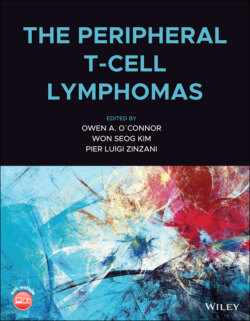Читать книгу The Peripheral T-Cell Lymphomas - Группа авторов - Страница 86
Cutaneous T‐cell Lymphoma
ОглавлениеCTCL contains a broad spectrum of diseases: Mycosis fungoides and Sézary syndrome account for more than 60% of CTCL. The tumor cells of Mycosis fungoides and Sézary syndrome represent CD4+ helper T cells. Several CTCL models have been established to define mechanisms underlying CTCL and identify therapeutic targets. Patients with CTCL show high IL‐15 protein levels in the skin. Hypermethylation within the IL‐15 promoter suppresses binding of the ZEB1 transcriptional repressor to the locus, leading to increase of IL‐15 transcription in CD4+ T cells [41]. Fehniger et al. reported a transgenic mouse model using the MHC class I promoter to drive IL‐15 expression [42]. IL‐15 transgenic mice developed fatal leukemia with involvement of multiple organs including skin around 12–30 weeks and have served as a preclinical CTCL model and were useful in the discovery that interruption of IL‐15 signaling via an HDAC inhibitor is a promising treatment strategy for CTCL [41, 42].
JAK3‐activating mutations are recurrently observed in CTCL [43]. Human JAK3 shows four mutation hotspots: M511I, R657Q, A572V, and 573V. Cornejo et al. reported the retroviral transduction of active JAK3A572V mutant cDNA into 5‐fluorouracil‐treated murine bone marrow cells followed by transplantation into lethally irradiated mice [44]. The recipient mice developed CD8+ lymphoproliferative diseases with skin involvement, mimicking a leukemic form of CTCL [44]. Rivera‐Munoz et al. generated a JAK3A572V knock‐in mouse model expressing the JAK3A572V mutant from the endogenous Jak3 locus also developed a leukemic form of CTCL [45]. Phosphorylation of downstream targets of JAK3 was dose dependent: phospho‐Stat3 and Stat5 were observed even in thymocytes from heterozygous JAK3A572V mutant mice, while phospho‐Akt and Erk1/2 were seen only in those of homozygous. Treatment with tofacitinib, a pan‐JAK inhibitor reduced growth of JAK3A572V‐positive CD4+ and CD8+ malignant cells. This result suggests that inhibition of constitutively activated JAK3 may improve treatment outcomes of CTCLs.
